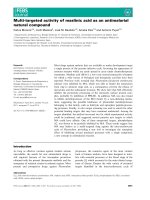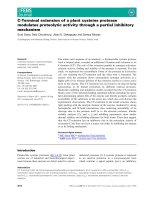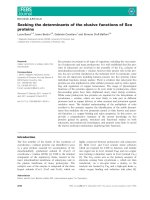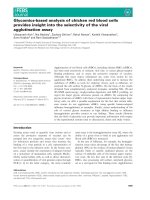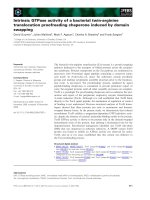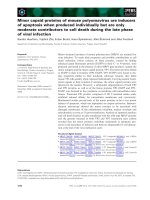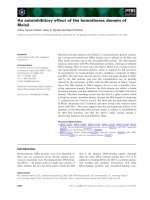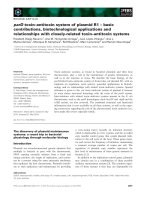báo cáo khoa học: "Four year experience of sarcoma of soft tissues and bones in a tertiary care hospital and review of literature" ppt
Bạn đang xem bản rút gọn của tài liệu. Xem và tải ngay bản đầy đủ của tài liệu tại đây (370.06 KB, 7 trang )
RESEARC H Open Access
Four year experience of sarcoma of soft tissues
and bones in a tertiary care hospital and review
of literature
Tayyaba Z Ansari
1*
, Nehal Masood
1
, Asra Parekh
1
, Rabab Z Jafri
1
, Syed N Niamatullah
2
, Adnan A Zaidi
3
and
Masood Umer
1
Abstract
Background: Sarcoma encompasses an uncommon group of cancer and the data is insufficient from Pakistan.
We report our four years experience of Sarcoma of soft tissues and bones.
Methods: This cross sectional study was carried out at Aga Khan University Hospital from 2004 to 2008. The
patients were divided into two groups from the outset i.e. initially diagnosed and relapsed group and separate
sub group analysis was conducted.
Results: Out of 93 newly diagnosed patients, 58 belonged to bone sarcoma and 35 to soft tissue sarcoma group.
While for relapsed patients, 5 had soft tissue sarcoma and 9 had bone sarcoma . Mean age was 32.5 years. At
presentation, approximately two third patients had localised disease while remaining one third had metastatic
disease. The Kaplan Meier estimate of median recurrence free survival was 25 months, 35 months, and 44 months
for Osteogenic sarcoma, Ewing’s sarcoma and Chondrosarcoma respectively. For Leiomyosarcoma and Synovial
sarcoma, it was 20 and 19 months respectively. The grade of the tumour (p = 0.02) and surgical margin status
(p = 0.001) were statistically significant for determination of relapse of disease.
Conclusion: The median recurrence free survival of patients in our study was comparable to the reported literature
but with significant lost to follow rate. Further large-scale, multi centre studies are needed to have a more
comprehensive understanding of this heterogeneous disease in our population.
Background
Theskeletonandsofttissuecompriseapproximately
75% of the average body weight but the cancer arising
from these parts represent 1% of adult and 15% of
pediatric malignancies [1]. The diversity and rarity of
occurrence make their comprehensive understanding a
difficult task. Broadly, sarcoma compri se of tw o distinct
entities i.e. Bone sarcoma and Soft tissue sarcoma. Sar-
comas have been associated with earlier radiation ther-
apy,toxicexposureandgeneticconditionsbutno
clearly defined aetiology has been identified [2]. The his-
tological grade of the tumour is one of the most impor-
tant prognostic variables for soft tissue sarcoma [1,3,4 ].
Complete staging and treatment planning by multidisci-
plinary team of cancer specialists is required to deter-
mine the optimal treatment for these patients [5]. The
role of chemotherapy is less well defined for soft tissue
sarcoma while some bone sarcomas are chemo-sensitive
and therefore, chemotherapy is an integral component
of their treatment protocols. Bone sarcomas disseminate
almost exclusively through the blood as bones lack a
lymphatic system. Early lymphatic spread to regional
nodes has only rarely been reported [2]. It usually affects
the younger age group, and hence the social burden of
disability and morbidity is huge for any community.
With this background, we planned to u nder take a
study to r eport our four year experience of dealing with
sarcoma patients at a tertiary care hospital as data is
limited from our country. Our population exhibits a
very diverse b ehaviour in terms of t umour biology,
* Correspondence:
1
Aga Khan University Hospital, Stadium Road, P.O. Box 3500, Karachi 74800,
Pakistan
Full list of author information is available at the end of the article
Ansari et al. World Journal of Surgical Oncology 2011, 9:51
/>WORLD JOURNAL OF
SURGICAL ONCOLOGY
© 2011 Ansari et al; licensee BioMed Central Ltd. This is an Open Access article distributed under the terms of the Creative Commons
Attribution License ( which permits unrestricted use, distribution, and reproduction in
any medium, provided the original work is properly cited.
disease manifestation and outcome and we wanted to
explore these factors in our ethnically varied population.
Materials and methods
This descript ive, cross sectional study was conducted at
Aga Khan University Hospital, Karachi. Our centre gets
referral from all over the country. The method of refer-
ral is, however, not uniform . Sometimes primary physi-
cians refer the patients and in other instances people
make self-referrals.
The charts of the patients with diagnosis of the sarcoma
were reviewed from a period of 2004 to 2008 after formal
approval from the Institutional Ethical Review Board. Only
adult patients with age of more than 16 years were
included.
Statistics
The data was analyzed in SPSS version 16.0. The
descriptive analysis was done for the demographics a nd
clinical characteristics of the patients. From the outset,
two separate descriptive analyses were done, for relapsed
and no relapsed cases. The further analysis was done on
the basis of diagnosis whether soft tissue or bone sar-
coma, localised versus metastatic disease a nd different
modalities of treatment. The Chi square test was applied
for univariate analysis for determining the significance
of individual categorical variables for recurrence and
Kaplan Meier survival curves were obtained for recur-
rence free survival.
Results
The tot al number of p atients with the diagnosis of Sar-
coma was found to be 130 during this four year period
but the analysis was done for only 107 patients as 23
patients were excluded either because of inability to
retrieve the charts from the Medical Record department
or inadequate information in the charts. The analysis,
thus done, comprised of 14 relapsed patients who had
been referred for relapsed disease after having received
the initial treatment somewhere else and 93 ne wly diag-
nosed patients. The distribution of patients is shown in
the flow diagram Figure 1.
Among newly diagnosed patients in bone sarcoma
category, 2 2 patients (23.7%) had Osteogenic sarcoma,
22 patients (23.7%) had Ewing’s sarcoma and 14 patients
(15%) had Chondrosarcoma. The soft tissue sarcomas
were found to be less frequent in our analysis. The soft
tissue sarcomas included Synovial sarcoma, Leiomyosar-
coma, Fibrosarcoma, Liposarcoma and other rare sarco-
mas. The Synovial sarcoma and Leiomyosarcoma were
found in 13 patients (14%) each, followed by Fibrosar-
coma 6 pat ients (6%), Lip osarcoma in 2 patients (2%)
and the other rare sarcomas in less than 1% of the
cases. (Figure 2 Pie chart)
The mean age group for t he whole study population
was 32.5 years with the range of 18 to 47 years. The
stage of the disease at presentation was generally similar
in both group of sarcoma patients with 67.8% of patients
had localised disease and 34% had metastatic disease
while staging details were missing for 2 patients with
Ewing’s sarcoma. The median follow up duration was 44
months (18-72 months).
Osteogenic Sarcoma
There was unequal gender distribution in Osteogenic sar-
coma with the male to female ration of 2.8:1. The diagno-
sis had been established by needle (trucut) biopsy for most
of cases, but a few cases had excisional biopsies and
exploratory surgeries as part of investigative work up.
The sub-group analysis of 22 patients with Osteogenic
sarcoma showed that 16 had localised disease and 6 had
metastatic disease at presentation. The long bones of the
extremity were the main site of involvement in Osteogenic
sarcoma with 17 cases (77%) of lower extremity and 4
cases (18%) of upper extremity location, while the site was
not documented for one patient. Of these 16 patients with
localised disease, twelve received neoadjuvant chemother-
apy. Most patients tolerated the chemotherapy well and
the commonly encountered side effects were nausea,
vomiting, and mucositis. Only few patients had febrile
neutropenia (grade 4 toxicity) but recovered fairly quickly
with no definite localizing source of fever. Seven patients
in the neo-adjuvant group had a good clinical response to
the therapy while 2 had confirmed responsive disease radi-
ologically as per RECIST criteria; however, the re-staging
work up was missing for 3 patients.
The neoadjuvant chemotherapy was also given to 4
patients with metastatic lung nodules and subsequently
3 of them had limb salvage surgery with metastatectomy
of lung nodules in the same sitting. Nevertheless, 1
patient did not have good response to neoadjuvant che-
motherapy and underwent amputation. The histopat hol-
ogy revealed a variable percentage of necrosis; more
than 90 percent in two patients, 50 to 70 percent in
three, and less than fifty percent in three patients.
Nonetheless, one patient did not have any ne crosis after
neo-adjuvant chemotherapy and there had been no
comment on the percentage of necrosis in the final his -
topathology report for three patients. Among the four
patients in the metastatic group who received neoadju-
vant chemotherapy, one had more than 90 percent
necrosis, 1 patient did not have any necrosis, while the
percent age of necrosis has not be en documented for the
other two. The details are shown in Figure 3.
The two categorical variables significantly associated
with the relapse of the disease in univariate analysis
were grade of the tumour (p = 0.02) and surgical margin
status (p = 0.001) as shown in Table 1.
Ansari et al. World Journal of Surgical Oncology 2011, 9:51
/>Page 2 of 7
The relapse rate after limb salvage and amputation
could not be compared directly because of small num-
ber of patients who underwent amputation. The patients
who relapsed among limb salvage surgery versus no
relapse in same group could also not be compared for
the same reason of having fewer numbers of patients.
However, the recurren ce free sur vival for three different
sub-types of bone sarcoma is shown in Figure 4. The
Kaplan Meier estimate of median recurrence free survi-
val was 25 months, 35 months, and 44 months for
Osteogenic sarcoma, Ewing’ s sarcoma and Chondrosar-
coma respectively. Four patients with Osteogenic sar-
coma had recurrent disease at primary site wh ile rest
presented with distant recurrence predominantly with
lung nodules detected on routine surveillance imaging.
Ewing’s Sarcoma
The gender distribution was 1:1 in Ewing’ s sarcoma.
The neoadjuvant chemotherapy was given to 14 patients
with Ewing’s sarcoma and among them 3 had metastatic
disease. The most commonly used chemotherapy regi-
men comprised of Cyclophosphamide, Vincristine,
Adriamycin, Ifosfamide and Etoposide. The local treat-
ment for localised disease was addressed at 12 - 14
weeks depending on the response to chemotherapy [6].
Chondrosarcoma
Patients with localised Chondrosarcoma had primary
upfront surgery. Out of 14 patients 11 had localised dis-
ease and only one patient had positive margins post-
operative and treated by adjuvant radiation.
Soft Tissue Sarcoma
The soft tissue sarcoma was under represented in our
study and showed a trend towards female preponderance.
Majority of the patients i .e. 29 patients (31.2%) with
soft tissue sarcoma had upfront surgery with negative
margins in 21 patients and positive in 3 patients while
Bone Sarcoma
n= 58
Osteosarcoma=22
Ewing’s sarcoma=22
Chondrosarcoma=14
Synovial Sarcoma=13
Leiomyosarcoma=13
Fibrosarcoma=6
Liposarcoma=2
Rare Sarcoma=1
Relapsed cases
n= 14
Excluded
n= 23
Sarcoma
n= 107
Newly diagnosed
cases
n= 93
Soft tissue Sarcoma
n = 35
Soft tissue Sarcoma
n= 9
Bone Sarcoma
n= 5
Sarcoma
n=130
Figure 1 Schematic Representation of Distribution of Entire Study Cohort Patients. Out of 107 analy zed cases, 93 were newly diagnosed
and 14 were relapsed cases. Among newly diagnosed patients, 35 patients had soft tissue sarcoma and 58 had bone sarcoma. Synovial
Sarcoma, Leiomyosarcoma, Fibrosarcoma and Liposarcoma were the main subtypes of soft tissue sarcoma. While for bone sarcoma,
Osteosarcoma, Ewing’s sarcoma and Chondrosarcoma were the main diagnosis.
Ansari et al. World Journal of Surgical Oncology 2011, 9:51
/>Page 3 of 7
Figure 2 Percentage of Sub Categories of Sarcoma. Among 93 newly diagnosed patients, the percentage of Osteosarcoma, Ewing’s sarcoma,
Chondrosarcoma, Synovial sarcoma, Leiomyosarcoma, Fibrosarcoma and other rare sarcoma were 24%, 24%, 15%, 14%, 14%,6% and 3%
respectively.
Amputation
n=1
Necrosis not
documented
Osteogenic sarcoma Patients who
received Neo-adjuvant
chemotherapy
Lost to follow
n=3
No Relapse
n=4
Positive margin=1
Negative Margin=3
Necrosis (<50%) = 3
Necrosis not
documented=1
Relapse=4
Positive margin=2
Negative Margin=2
Necrosis >90% = 1
50-70% = 3
Lost to follow Lost To follow=3
Limb Salvage
n=11
Amputation
n=1
Localized disease
n=12
Limb Salvage with
Metastatectomy
n=3
Positive margin=1
Negative margin=2
Necrosis > 90% =1
No necrosis =1
Not documented =1
Metastatic Disease
n=4
Figure 3 Distribution of Osteosarcoma Patients who Received Neo-adjuvant Chemotherapy. 16 patients with osteosarcoma received
neoadjuvant chemotherapy. This included 4 patients with metastatic disease and 12 patients with localised disease. 11 of these 12 patients
underwent limb salvage surgery but one ended up having amputation. 3 patients were lost to follow after limb salvage surgery while 4 relapsed
and 4 did not relapse as per last follow up. The flow chart also shows the postoperative pathological characteristics of the relapse and no
relapse patients.
Ansari et al. World Journal of Surgical Oncology 2011, 9:51
/>Page 4 of 7
margin status was not documented for 10 patients. Most
patients had high grade tumour and five patient s with
Leiomyosarcoma received anthracyclin es and Ifosfamide
based adjuvant chemotherapy.
The recurrence free survival is shown in Figure 5. The
recurrence free survival for Leiomyosarcoma and Syno-
vial sarcoma was 20 and 19 months respectively.
The outcome of entire cohort of newly diagnosed
cases has been shown in Table 2.
Discussion
Sarcomas represent the heterogeneous group of cancer
with diverse tumour biology. Chemotherapy, being the
main stay of treatment for certain sub-type s of bone sar-
coma e.g. Ewing’s sarcoma, has proved to improve the
recurrence free survival in adjuvant setting in Osteogenic
sarcoma [7], but has a controversial role in soft tissue
sarcomas. Wide adequate surgical resection with patholo-
gically proven clea r margins is the most effective thera-
peutic approach for management of soft tissue sarcoma.
Though the numbers of patients were small in our
study but this was consistent with the overall incidenc e
of the sarcoma and the rarity of the disease [8]. The age
group affected comprised of young adults with predomi-
nance of males in Osteogenic sarcoma as c ompared to
females which was in contrast to the reported literature
[2]. It is not known whether this gender difference is
related to epi genetic factors in our population or reflects
a general social background of the community where
men are more privileged than women and hence the
greater access to medical facilities. One study from India
has also reported a similar gender difference in the inci-
dence of Osteogenic sarcoma [9,10]. Nevertheless, female
preponderance that had been shown in soft tissue sar-
coma could be related to the significant number of cases
of Leiomyosarcoma arising from the uterine muscle.
Successful management of sarcomas and localised
Osteogenic sarcomas requires careful coordination and
timi ng of staging studies, biopsy, surgery, and preopera-
tive and postoperative chemotherapy. Majority of the
cases of localised Osteogenic sarcomas did receive
Table 1 Univariate Analysis of Categorical Variables for
Relapse of the Disease
Number of Patients n (%)
Variables Relapse No relapse p value
Grade of the Tumour
High grade 39(41.9%) 25(26.9%) 0.02
Low grade 0(0%) 4(4.3%)
Not Documented
1
0(0%) 3(3.2%)
Positive Surgical Margins
Yes 5(5.4%) 4(4.3%) 0.001
No 15(16.1%) 26(28%)
Not Documented
2
19(20.4%) 2(2.2%)
1
Grade of Tumour was not documented in 5 patients and outcome
information was missing in 22.
2
Margin status was not documented in 31 patients and outcome information
missing for 10 patients.
Grade of the tumour was classified pathologically as high or low grade. The
margin was considere d positive if tumour was present within 1 mm of
resected specimens. The p-values were statistically significant for the grade of
the tumour and the margins status post-operatively in determining the
relapse of the disease.
Recurrence
f
reeSur vivaldistr ibution
f
unc tion
0
0.1
0.2
0.3
0.4
0.5
0.6
0.7
0.8
0.9
1
0 1020304050
Timeinmonths
ProbabilityofRecurrencefre esurvival
Osteos arcoma Chondros arcoma Ewing'sSarcom
a
Figure 4 Recurrence-free Survival of Bone Sarcoma. The time in
months is shown along x- axis and probability of survival along y-
axis. The solid line indicates the recurrence free survival of
Osteosarcoma, the dotted lines indicates for Chondrosarcoma and
dashed lines depicts for Ewing’s sarcoma. 3 year recurrence free
survival was 25% for Osteosarcoma, 57% for Chondrosarcoma, and
49% for Ewing’s sarcoma.
Leiomyosarcoma
S
y
novial Sarcoma
Figure 5 Recurrence-free Survival of Two Main Types of Soft
Tissue Sarcoma. The probability of survival along y- axis is plotted
as function of time in months along x-axis for 2 major sub-types of
soft tissue sarcoma. The dotted line indicates Synovial sarcoma and
dashed represents Leiomyosarcoma. The median survival was only
19 months for Synovial sarcoma and 20 months for
Leiomyosarcoma.
Ansari et al. World Journal of Surgical Oncology 2011, 9:51
/>Page 5 of 7
neoadjuvant chemotherapy in our study before proceed-
ing with definitive surgery. It was i n keeping with the
revised standards for the management of Osteogenic
sarcoma that had been established in 1990 [2]. Limb-sal-
vage surgery has now been considered a standard opera-
tion for selected cases. Approximately 95% of
Osteogenic sarcomas can be treated successfully with
this technique [2]. Many studies have targeted the qual-
ity of life issues with limb salvage versus amputation but
with conflicting results [11,12].
Despite multidisciplinary involvement and appropr iate
planning of individual cases, the recurrence rate could
not be compared between limb salvage and amputati on;
andalsobetweentwogroupsoflimbsalvagesurgeries
who relapse versus who do not relapse mainly because
of smaller sample size. However, the recurrence free
survival for Osteogenic sarcoma was comparable to few
studies as per reported literature but definitely inferior
for soft tissue sarcoma [13]. Therefore, we need larger
studies and longer follow up period before commenting
on this any further.
The two most important determinant of local recur-
rence in previous studies were the surgical margins and
the response to chemotherapy and our study corroborated
these findings in emphasizing the importance of negative
surgical margins for successful management of sarcoma
[13]. In our cohort, 3 patients had positive margins after
limb salvage surgery. One of them is alive without recur-
rence but this patient had 90 percent necrosis on surgical
specimen. One had local recurrence in 6 months time
which had been treated with re-excision and the third one
had multiple recurrences treated with surgery and che-
motherapy and subsequently lost to follow. This patient
had poor response to neo-adjuvant chemotherapy with
significant residual tumour initially. This again highlights
the importance of response to chemotherapy for recur-
rence free survival. The rest of the patients who relapsed
had distant recurrences rather than local.
The soft tissue sar coma group wa s, somewhat, unde r
represented in our study mainly due to variable pattern
of referrals i.e. most patients with low grade soft tissue
sarcoma do not follow the oncologists after primary
surgical resection. We primarily see patients with high
grade tumours referred for adjuvant chemotherapy or
for palliative chemotherapy in un-resectable cases. Adju-
vant chemotherapy for high grade soft tissue sarcoma
remains divisive but has been given to most patients
with high grade tumours based on results of earlier
meta-analyses which have demons trated a r eduction in
local and distant recurrence rate and trend towards
improved overall survival with adjuvant chemotherapy
[14,15]. Recent trials have also shown an advantage in
disease free survival and overall survival with Ifosfamide
and Adriamycin combination chemotherapy [16,17].
Radiotherapy has also been used for improving the local
control both before and after surgery depending on the
individual case of high grade and large soft tissue sar-
coma [18].
A major limitation of the study was the wide variation
in treatment po licies in small number of patients and
hence, the analysis was based on small groups of hetero-
geneous sarcoma population. Also, the lost to follow
rate was significantly high in our study for many rea-
sons. The financial burden of the treatment is substan-
tial, and people tend to disappear once the treatment is
declared completed for the fear of more expenses asso-
ciated with regular follow up visits. For the same reason
sig nificant number of patients have the tendency not to
complete their treatment as soon as they start feeling
better and then return later with extensive disease. Yet
another factor is inadequate literacy level due to which
many fail to underst and the importance of follow up
visits. Some people even argue about the significance of
these visits once the treatment is deemed completed.
Conclusion
Sarcoma, though a rare cancer group, is associated with
considerable morbidity and disability in younger group
of the community. Our results showed the different
characteristics of sarcoma patients, their course and
Table 2 Outcome of Entire Cohort of Newly Diagnosed Sarcoma Patients
Outcome Osteo-
sarcoma
Chondro-
sarcoma
Ewing’s
Sarcoma
Lipo-
sarcoma
Fibro-
sarcoma
Synovial
Sarcoma
Leiomyo-
sarcoma
Total
Alive with no recurrence 8 4 7 2 1 3 3 29
Alive with recurrence and taken
treatment
00 000202
Alive with recurrence/on
supportive care
01 100316
Died 1 2 4 0 3 0 3 13
Lost to follow 13 7 10 0 2 5 6 43
Total 22 14 22 2 6 13 13 93
The outcome of all the newly diagnosed patients is categorized on the basis of whether they are alive without recurrence, with recurrence but on treatment or
supportive care, died or lost to follow.
Ansari et al. World Journal of Surgical Oncology 2011, 9:51
/>Page 6 of 7
outcome over a four year period. Multidisciplinary
involvement is essential for appropriate and successful
management of individual cases. The median recurrence
free survival was comparable in our study to the
reported literature but with significant lost to follow
rate. Further large scale, multicent re prospective studies
are needed to have a more comprehensive understand-
ing of the behaviour and outcome of this heterogeneous
disease in our population. Also, there is a need for
increasing awareness among general public for meticu-
lous follow up.
Acknowledgements
I would like to acknowledge the great efforts of my sisters Huda Ansari and
Nida Ansari for making this a successful project, and rendering their
constant support from scratch to final manuscript.
Author details
1
Aga Khan University Hospital, Stadium Road, P.O. Box 3500, Karachi 74800,
Pakistan.
2
Liaquat National Hospital, National Stadium Road, P.O. Box 3500,
Karachi 74800, Pakistan.
3
Shaukat Khanum Cancer Memorial Hospital, Main
Clifton Road, Clifton, Karachi, Pakistan.
Authors’ contributions
TZA and NM conceived the study. TZA performed the literature review,
designed the study, formulated the questionnaire, carried out the statistical
analysis and wrote the main manuscript. NM supervised the study and
proofread the manuscript.
AP and RZJ collected the data by reviewing the files, filled in the
questionnaires, entered the data in SPSS and helped in the analysis. SNN,
AAZ, and MU contributed in the study subjects from their patients’ pool. All
authors read and approved the final manuscript.
Competing interests
The authors declare that they have no competing interests.
Received: 20 January 2011 Accepted: 17 May 2011
Published: 17 May 2011
References
1. Mazanet R, Antman Karen H: Sarcoma of Soft Tissue and Bone. Cancer
1991, 68:463-473.
2. Brennan M, Singer S, Maki R, O’Sullivan B: Sarcomas of the soft tissues and
bone. In Cancer: Principles and Practice of Oncology Edited by: DeVita VT,
Hellman S, Rosenberg SA 2008, 8:1742-1833.
3. Coindre JM, Terrier P, Guillou L, Le Doussal V, Collin F, Ranchere D, Sastre X,
Vilain MO, Bonichon F, N’guyen BB: Predictive value of grade for
metastasis development in the main histologic types of adult soft tissue
sarcomas: A study of 1240 patients from the French Federation of
Cancer Centers Sarcoma Group. Cancer 91 2001, 10:1914-26.
4. Vraa S, Keller J, Nielsen OS, Sneppen O, Jurik AG, Jensen OM: Prognostic
factors in soft tissue sarcomas: the Aarhus experience. Eur J Cancer 34
1998, 12:1876-82.
5. Adult soft tissue sarcoma treatment. [ />treatment/adult-soft-tissue-sarcoma/healthprofessional#Section_229].
6. Grier HE, Krailo MD, Tarbell NJ, Link MP, Fryer CJH, Pritchard DJ,
Gebhardt MC, Dickman PS, Perlman EJ, Meyers PA, Donaldson SS, Moore S,
Rausen AR, Vietti TJ, Miser JS: Addition of ifosfamide and etoposide to
standard chemotherapy for Ewing’s sarcoma and primitive
neuroectodermal tumor of bone. N Engl J Med 2003, 348(8):694-701.
7. Link MP, Goorin AM, Miser AW, Green AA, Pratt CB, Belasco JB, Pritchard J,
Malpas JS, Baker AR, Kirkpatrick JA, Ayala AG, Shuster JJ, Abelson HT,
Simone JV, Vietti TJ: The effect of adjuvant chemotherapy on relapse-free
survival in patients with osteosarcoma of the extremity. New Eng J Med
1986, 314(25):1600-1606.
8. Damron TA, Ward WG, Stewart A: Osteosarcoma, chondrosarcoma, and
Ewing’s sarcoma: National Cancer Data Base Report. Clin Orthop Relat Res
2007, 459:40-7.
9. Yeole BB, Jussawalla DJ: Descriptive epidemiology of bone cancer in
greater Bombay. Indian J Cancer 1998, 35:101-6.
10. Guo W, Xu W, Huvos AG, Healey JH, Feng C: Comparative frequency of
bone sarcomas among different racial groups. Chin Med J (Engl) 1999,
112:1101-4.
11. Greenberg DB, Goorin A, Gebhardt MC, Gupta L, Stier N, Harmon D,
Mankin H: Quality of life in osteosarcoma survivors. Oncology (Huntingt)
1994, 8(11):19, discussion 25, 32, 35.
12. Christ GH, Lane JM, Marcove R: Psychosocial adaptation of long term
survivors of bone sarcoma. J Psychosocial Oncol 1995, 13:1-22.
13. Bacci G, Ferrari S, Mercuri M, Bertoni F, Picci P, Manfrini M, Gasbarrini A,
Forni C, Cesari M, Campanacci M: Predictive factors for local recurrence in
osteosarcoma: 540 patients with extremity tumors followed for
minimum 2.5 years after neoadjuvant chemotherapy. Acta Orthop Scand
1998, 69(3):230.
14. Tierney JF, Stewart LA, Parmar MKB, Sarcoma Meta-analysis Collaboration:
Adjuvant chemotherapy for localised resectable soft-tissue sarcoma of
adults: meta-analysis of individual data. Lancet 1997, 350(9092):1647-54.
15. Frustaci S, Gherlinzoni F, De Paoli A, Bonetti M, Azzarelli A, Comandone A,
Olmi P, Buonadonna A, Pignatti G, Barbieri E, Apice G, Zmerly H, Serraino D,
Picci P: Adjuvant chemotherapy for adult soft tissue sarcomas of the
extremities and girdles: results of the Italian randomized cooperative
trial. J Clin Oncol 2001, 19(5):1238-47.
16. Woll PJ, Van Glabbeke M, Hohenberger P, Le Cesne A, Gronchi A,
Hoekstra HJ, Radford JA, Van Coevorden F, Blay J, EORTC Soft Tissue & Bone
Sarcoma Group: Adjuvant chemotherapy with doxorubicin and
ifosfamide in resected soft tissue sarcoma: Interim analysis of
randomised phase III trial. J Clin Oncol 2007, 25(18S):10008.
17. Pervaiz N, Colterjohn N, Farrokhyar F, Tozer R, Figueredo A, Ghert M: A
systematic meta-analysis of randomized controlled trials of adjuvant
chemotherapy for localised resectable soft-tissue sarcoma. Cancer 2008,
113(3):573-81.
18. Yang JC, Chang AE, Baker AR, Sindelar WF, Danforth DN, Topalian SL,
DeLaney T, Glatstein E, Steinberg SM, Merino MJ, Rosenberg SA:
Randomized prospective study of the benefit of adjuvant radiation
therapy in the treatment of soft tissue sarcomas of the extremity. J Clin
Oncol 1998, 16(1):197-203.
doi:10.1186/1477-7819-9-51
Cite this article as: Ansari et al.: Four year experience of sarcoma of soft
tissues and bones in a tertiary care hospital and review of literature.
World Journal of Surgical Oncology 2011 9:51.
Submit your next manuscript to BioMed Central
and take full advantage of:
• Convenient online submission
• Thorough peer review
• No space constraints or color figure charges
• Immediate publication on acceptance
• Inclusion in PubMed, CAS, Scopus and Google Scholar
• Research which is freely available for redistribution
Submit your manuscript at
www.biomedcentral.com/submit
Ansari et al. World Journal of Surgical Oncology 2011, 9:51
/>Page 7 of 7
